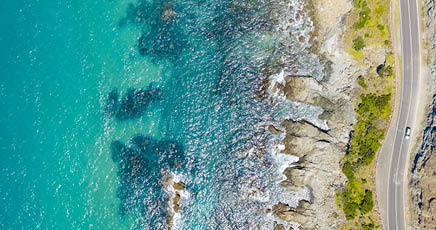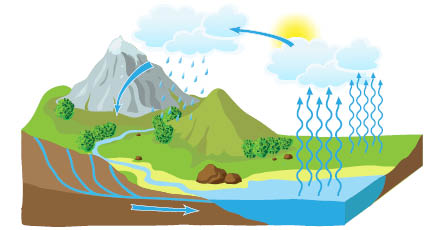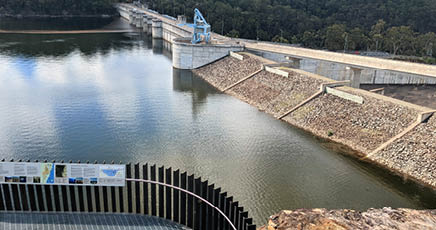LEARNING ACTIVITY
STORY
Seeing his little cousin Kai throw things down the drain, forced Amir to pay attention to his own actions. How much left over food, hair and body products, dishwashing liquid, chip packets and lolly wrappers ended up in the drain because they weren’t properly disposed of. Where do these items end up?
Then Amir started to think about the actions of his family, his friends, his classmates and his community. Will the small amount of rubbish that each of them accidentally threw in the drain, did it really make a difference?

Water moves through the environment by the Water Cycle. This activity investigates the journey of a river through the catchment. Follow water through the environment and explore the changes to water quality over time.
This learning activity is the first part of a sequence of 5 individual learning activities focused on Catchment Management. The order of these learning activities are: the story of a river, water sustainability, what’s in a drop?, the drain is just for rain and where the river meets the sea.
For children to:
- understand the journey of water through a catchment and the natural water cycle
- learn how different pollutants can enter the waterways
- understand that competing pressures for water security in a catchment
- appreciate that what happens on land can impact our rivers and ocean.
This activity can be undertaken at any time of year.
Introduction
The story of a river learning activity investigates the journey of water through the catchment, from the mountains to the sea. Fresh water is a finite resource and is essential for all land plants and animals to survive. Explore the competing demands for water in a typical catchment.
*Adult preparation for the activity 20 minutes
Checklist
- A tablespoon of soil/dirt
- 5 – 10 broken pieces of twigs or sticks
- A teaspoon of clay in water
- A teaspoon of chocolate drink powder
- 3 drops yellow food colouring and 1 square of toilet paper
- 10 sultanas
- Tablespoon of detergent
- 10 small rocks
- 5 small pieces of aluminium foil scrunched in balls
- ¼ piece of A4 paper ripped in strips
- Small plastic bag cut into pieces
- Tablespoon of vegetable oil
- Tablespoon of charcoal
- 20cm of plastic string or fishing line
- Tablespoon of sand
Instructions
STEP 1:
What is a water catchment?
Have a discussion as a class on catchment management, the water cycle, where freshwater comes from and why it is important for life.
Use the Australian Topographic Drainage Divisions and River Regions map to determine the catchment you live in.
STEP 2:
Land uses in your catchment
As a class discuss the different land uses present in your local area and how they use water. List these in the activity sheet.
STEP 3:
Follow the journey of a river through the catchment.
Using the activity sheet, read the story of a river, or make up your own, and ask the students to add the item in their jar to the container of water. Students put small amounts of household material (detergent, oil, dirt, chocolate powder, plastic etc.) to represent land uses and environmental issues.
STEP 4:
Clean-up our waterways
Following the activity sheet, the students can use plastic strainers to remove the floating pollution and discuss ways of stopping it returning. Once the water has settled, students can scoop off the cleaner water into a separate container.
Discussion: What can we do to stop these things getting in the waterways and the ocean?
Extension Activity
Make your own catchment.
Use the activity sheet to make your own catchment. In two groups, make a natural or urban catchment model. Compare the flow of water between the two models.
Curriculum and Framework Links
SCIENCE
Year 7: ACSSU111, ACSSU112, ACSSU116, ACSHE120, ACSHE121, ACSIS124, ACSIS125, ACSIS130, ACSIS131, ACSIS132
Year 8: ACSHE135, ACSIS140, ACSIS145, ACSIS146, ACSIS234
Year 9: ACSSU175, ACSSU176, ACSIS164, ACSIS165, ACSIS170, ACSIS172, ACSIS174
Year 10: ACSSU189, ACSHE191, ACSHE194, ACSIS199, ACSIS204, ACSIS206, ACSIS208
Biology
Unit 1: Biodiversity and the interconnectedness of life
Earth and Environmental Science
Unit 1: Introduction to Earth systems
Unit 3: Living on Earth – extracting, using and managing Earth resources
Unit 4: The changing Earth – the cause and impact of Earth hazards
HUMANITIES AND SOCIAL SCIENCES
Year 7: ACHASSI152, ACHASSI155, ACHASSI154, ACHASSI155, ACHASSI156, ACHASSI158, ACHASSI159, ACHASSI160, ACHASSI161, ACHASSI162, ACHASSK183, ACHASSK185, ACHASSK187
GEOGRAPHY
Year 7: ACHGK037, ACHGK038, ACHGK040, ACHGK042, ACHGS047, ACHGS048, ACHGS049, ACHGS050, ACHGS051, ACHGS052, ACHGS054,
Year 8: ACHGK048, ACHGK050, ACHGK051, ACHGK053, ACHGS055, ACHGS056, ACHGS060, ACHGS062
Year 9: ACHGK065, ACHGS068, ACHGS070
Year 10: ACHGK070, ACHGK073, ACHGK074, ACHGK075, ACHGS079
Unit 1: Natural and ecological hazards
Unit 2: Sustainable places
Unit 3: Land cover transformations
HEALTH AND PHYSICAL EDUCATION
Year 7 & 8: ACPPS073
ETHICAL UNDERSTANDING
Exploring values, rights and responsibilities.
PERSONAL AND SOCIAL CAPABILITY
Social awareness
CURRICULUM CONNECTIONS
Outdoor Learning
CROSS CURRICULUM PRIORITY
Sustainability
Reference List
ONLINE RESOURCES
Discover more about the Natural Water Cycle and learn Why water is Important to all life on earth from the Environmental Education website.
Sydney Water has more information on the Natural Water Cycle and Sources of Water.
Bureau of Meteorology website section on Water Information has a lot of background information on water across Australia.
PRINTABLE RESOURCES
SEQ Water fact sheet on the Water Cycle.
Australian Topographic Drainage Divisions and River Regions map
WATCH
Watch the short video from Sydney Water to learn about the Water Cycle (3 minutes)
PLAY
Try the ABC’s Catchment Detox Game to see if you manage a river catchment and create a sustainable and thriving economy.
We value your feedback
When you have finished this learning activity, please tell us what you think with our survey.
Your feedback will help Landcare Australia improve the activities in the Junior Landcare Learning Centre.
Why not try one of our other Junior Landcare learning activities?
Love Letters to the Land
Biodiversity|First Nations Perspectives|Food Production|Waste Management
Creating a worm farm
Waste Management
Caring for our coasts: beach clean-up
Waste Management
Waterways: clean-up
Waste Management


